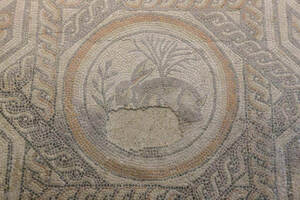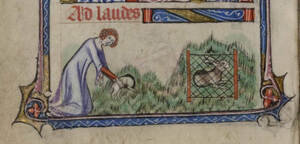From the Medieval Research Blog: "Medieval Rabbits: Ancient Symbolism, English Migration, and Manuscript Marginalia"

From its earliest recordings in African, Indian, and Egyptian cultures, the hare, which later became interchangeable with the rabbit, has been recognized as a symbol of generative powers.
In the ancient Greco-Roman world, the hare symbolized fertility, as well as love and lust. The hare was the favored sacrifice to the gods of love, Aphrodite and Eros. Consumption of the animal’s flesh was thought to enhance the beauty in the eater for several days. The animal’s body was also incorporated into medicines meant to cure conditions connected with sex.
Hares and rabbits were known as prolific breeders, but the classical world often exaggerated the creature’s capacity for reproduction. Aristotle, for example, believed the rabbit was capable of superfetation – that is, he thought a pregnant rabbit could become pregnant again, thereby gestating multiple litters at once. These ideas persisted into the Middle Ages, passed down by Aristotle and other philosophers such as Herodotus, as well as Pliny the Elder.

In his Naturalis historia, written during the first century, Pliny the Elder characterizes hares and rabbits as the only animals that superfetate, “rearing one leveret while at the same time carrying in the womb another clothed with hair and another bald and another still an embryo.” He also discusses how wild rabbits laid waste to Spain. Describing their fertility as “beyond counting,” he says that “they bring famine to the Balearic Islands by ravaging the crops.”
England, however, did not share Spain’s poor experience with rabbits. Although hares are indigenous to the British Isles, rabbits are not. They were introduced to England by the Normans in the 13th century and were raised for their meat and fur. They were also kept as pets and were a particular favorite of nuns.
This is an excerpt from "Medieval Rabbits: Ancient Symbolism, English Migration, and Manuscript Marginalia" by Dr. Emily McLemore. Read the full story.